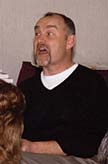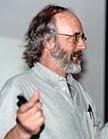
Matteson, founder of the Pinnacle Service Group, Lynnwood, Wash., polled the audience on who they felt provided the best customer service and why.
He spoke about the importance of leaving a good impression on a customer and making customers feel important. "People will forget what you say or what you do, but they won't forget how you make them feel," Matteson said.
"Customers don't buy because they are made to understand. They buy because they feel understood."
Matteson stated that "active listening is a muscle that grows stronger with use" and emphasized his point with the acronym L.P.Q.P., which he said stands for:
Key Suggestions
He also shared his "10 simple truths in customer service excellence."1. Manage information well. One of the keys to growth and effective response time in service is managing the vital information we must have on the customer.
2. Have or develop positive attitudes. Optimism is learned. Attitudes are contagious. Maintain an attitude of gratitude and abundance.
3. Form positive first impressions. How we present ourselves on arrival is extremely important. We are judged in five seconds by our customers. We must ensure we have organized, neat and clean uniforms, trucks, parts, and work orders.
4. Build rapport quickly. Find common ground with new customers. Listening is the No. 1 skill to assimilate and apply.
5. Communicate effectively. Speak with clarity, simplicity, and honesty. We need to eliminate "tech speak" (i.e., DDC, superheat, and delta-t). If a 12-year-old can understand what you say, then so will your customer.
6. Deal with difficult people effectively. We need to learn simple tools for dealing with the angry customer. Use the "I" message: "I understand how you feel. I would feel the same way. What would it take to make you happy?"
7. Understand that technicians are the best salespeople. We need to teach the four legs of the sales chair: trust, relationship, competence, and timing. After that, reward sales behavior and build long-term relationships.
8. Keep up with paperwork. Paperwork is vital to cash flow. Reward neat, on time, detailed, and signed paperwork. Great companies find ways to reduce the workload of an overburdened administration.
9. Educate employees. How do we make money and keep the technician's role vital? What are direct costs? What are indirect costs? What is gross profit? What is net profit? How do we improve the process, and what is the technician's role in the profit picture?
10. Demonstrate creative caring. Following up and going the extra mile will create "breakthrough relationships." These are the kind of relationships that lead to referrals and additional revenue streams.
Matteson said it is important to involve employees in the profit process because it gives them a better understanding of the importance of the selling process. It also makes them feel like they are a part of a team.
"Set your people up for success, not failure," he urged. "Admonish them in private and praise them in public."

Understanding CO
In another educational session, Rudy Leatherman, a consultant and trainer for the Bacharach Institute of Technical Training (www.bacharach-inc.com/training.htm), conducted a seminar on carbon monoxide (CO) poisoning. He asked attendees if they all had CO detectors in their homes that were approved by Underwriters Laboratories. All said yes."You might as well throw them all away," he said. "They are junk."
Leatherman believes the alarm threshold in parts per million (ppm) of detectable CO in UL-approved detectors is too high. He wants to educate service technicians and customers on the dangers of CO and the measures designed to prevent it.
"Some people say that 9 ppm of CO is OK," he stated. "It is not OK. UL-approved detectors are not required to alarm under 30 ppm."
He said that 9 ppm is the goal of outdoor air quality according to the Environmental Protection Agency (EPA). He noted the following information:
"Many doctors agree that continuous exposure to low levels of CO is dangerous," he said. "There may also be a link between CO poisoning and Parkinson's disease, S.I.D.S., and other neurological impairments."
Leatherman noted that CO can enter a building from a number of different sources, including auto exhaust and unvented or backdrafting appliances.
"I went into a supply house and the CO Experts alarm I was carrying went off right away," he said. "It turns out the CO was coming from the exhaust of a forklift."
Leatherman showed a slide of a motel room that had a fresh air intake located within a few feet of an automobile's exhaust pipe. "When I go into a motel room, I always pop off the top of the PTAC unit just to see where the fresh air intake is," he said.
He gave some tips on how and where to test for CO. "If you are testing the oven, check the exhaust port," Leatherman advised. "Look for soot in gas-fired equipment. Watch for changes in readings when the blower kicks on."
Leatherman's philosophy is to test everything. "We have a tendency to put blinders on when testing," he said. "We tend to only focus on the furnace."
He added four tips to extend sensor life:
1. Keep it dry.
2. Keep it dry.
3. Keep it dry.
4. Keep it from freezing.
Publication date: 06/14/2004

Report Abusive Comment